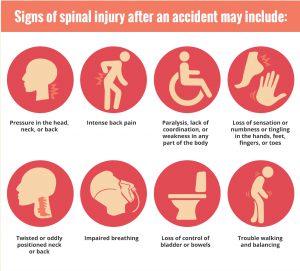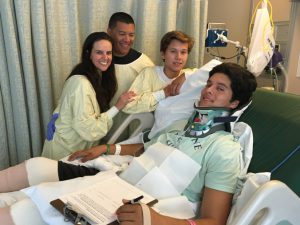Symptoms are experienced at the point of and below the affected level of the spine, and may be mild, moderate, or life-threatening. They may also vary depending upon the location of the injury, and if the injury is complete or incomplete.
COMMON SYMPTOMS
Signs and symptoms of a spinal cord injury may present immediately or some symptoms may be delayed as swelling and bleeding occur in or around the spinal cord. One or more of the following symptoms may occur with a spinal cord injury:
- Pain and numbness, or burning sensation
- Inability to move the extremities or walk
- Inability to feel pressure, heat, or cold
- Muscle spasms
- Loss of bladder or bowel control
- Difficulty breathing
SYMPTOMS BY REGION
There are three main areas in which a person may suffer spinal cord injury: cervical, thoracic, and lumbar. The fourth section of the spine (sacral), does not contain spinal cord tissue. Consequently, though you may cause damage to the sacral vertebrae or nerves, you will not damage the cord at that level.
1. Cervical (C1-C8) – Damage to the spinal cord in the cervical spine is considered the most severe because it can be life-threatening. Symptoms of cervical spinal cord damage may affect the arms, legs, mid-body, and even the ability to breathe on one’s own. The higher up in the cervical spine the damage occurs, the worse the injury. Symptoms may be felt on one or both sides of the body.
2. Thoracic (T1-T12) – Damage to the spinal cord in the thoracic spine typically affects the legs. Thoracic spinal cord damage high up in the area may affect blood pressure.
3. Lumbar (L1-L5) – Damage to the spinal cord in the lumbar spine typically affects one or both legs. Patients with lumbar spinal cord damage may also have trouble controlling their bladder and/or bowel function.
TREATMENT
Treating a spinal cord injury immediately, no matter what level it occurs, is key to the long-term prognosis for the patient. Medical professionals are able to evaluate the extent of the spinal cord injury and decide if surgery to decompress and stabilize the spinal cord is necessary. Finding a swift course of action to treat the patient’s symptoms will provide a better chance for easing the recovery process.
The prognosis for spinal cord injuries varies depending on the severity of the injury. There is always hope of recovering some function with spinal cord injuries. The completeness and location of the injury will determine the prognosis.
There are two levels of completeness in spinal cord injuries which impact the outlook:
- Complete spinal cord injuries – are those in which the signals between the brain and the spinal cord have been compromised. This results in a loss of motor and sensory function below the level of injury.
- Incomplete spinal cord injuries – are those where the signals from the brain to the spinal cord have not been compromised completely. In these situations, the patient has some motor and sensory function.
OUTLOOK
Spinal cord injuries in which the patient has not experienced paralysis have the greatest chance of recovery. However, those patients who do experience paralysis still have a remarkable chance that is improving with research every day. The sooner treatments are implemented to strengthen muscles below the level of the spinal cord injury, the better the prognosis.
The first year of recovery is the hardest as the patient is just beginning to adjust to his or her condition. The use of physical and occupational therapy during this time is the key to recovery. The extent of the function fully returning is typically seen in the first two years after the initial injury.
TREATMENT – OPTIONS
Treatment options vary with each spinal cord injury, but typically include:
- Physical therapy to strengthen the damaged area.
- Surgery is performed to remove anything which may have penetrated the spinal cord, or to achieve fusion (to limit movement in the spinal column around the spinal cord).
- Steroid injections are also used to reduce inflammation in the area of the spinal cord injury.
- Stem cells are being studied in the treatment of spinal cord injuries. With their ability to regenerate damaged tissue, there is a promising future for stem cells in the treatment of these injuries.
STAY MENTALLY HEALTHY
Mental health is a huge part of recovery for the spinal cord injury patient. Anxiety and depression are common in spinal cord injury patients. These patients will go through good days, and not so good days.
There may be days where the patient wants to give up completely on treatments, and will wonder if it is all worth it. Keeping up with the mental health of the spinal cord injury patient is incredibly important for the overall recovery. Mental health has been proven to directly relate to physical health.
HELP AND EMPATHY
Having a good support system is incredibly important to the overall outlook of a spinal cord injury patient. Spinal cord injury patients will need both physical and emotional support.
Caregivers should continually provide patients with:
- Physical support adjusting to their limitations
- Emotional support to encourage the patient to keep working on recovery
- Support with lifestyle changes
- Help finding new activities to promote mental health


